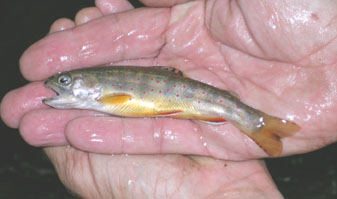In Search of Native Brook Trout
In Search of Native Brook Trout
By Bill Vanderford
While fishing with my Uncle Bob in the quiet serenity of a small mountain stream many years ago when I was a small boy, we had a terrific day catching tiny eastern brook trout or "native specs" as the locals called them. I wanted to take home a limit of the scrappy little fish, but Uncle Bob wouldn't hear of it. "These are the only mountain trout that are native to Georgian waters," he said. "Their habitat is slowly diminishing, and because of the growing human population, there won’t be any left before you die. So, let's just keep the ones that are hurt badly with the hooks, and let the others go."  I thought to myself, "He must be wrong. There are plenty of these fish.” However, Uncle Bob was right. Even though I hope that I am far from the end of my allotted time on this earth, most of the "native specs" have already disappeared. Only knowledgeable mountain people, a few biologists, and expert guide and fly fisherman, Bob Borgwat are able to find these diminutive fish with any regularity. The brookie is the only true trout that is native to the Eastern United States, and according to Lee Keefer, a DNR fisheries biologist out of the Lake Burton Hatchery, their range is limited by the fact that they don't compete well with other fish. Therefore, they are only found at higher elevations and in smaller streams where a natural barrier falls prevents other trout from migrating into the brook trout habitat. Native brook trout are easily distinguished by cream colored spots on a dark background. The spots along the back are elongated and appear worm-like, but the spots below the lateral line are round, red, and each is surrounded by a bluish halo. The fins along the bottom of brook trout have a distinctive white leading edge followed by a black streak with the rest of the fin displaying various shades of red, orange, and yellow. Tiny brook trout require clean, clear, cold streams in order to thrive. Therefore, the vast majority of these streams are small headwater streams found in scattered locations throughout the higher elevations of the Blue Ridge Mountains. Native brook trout rarely reach a maximum size of more than 9 to 10 inches, and a 12 incher is a rare trophy. Most examples of these fish are in the 3 to 6 inch variety. Like the brown trout, brook trout spawn in the fall in shallow depressions in clean stream gravel. Their eggs incubate though the winter months and hatch out in the early spring. According to Bob Borgwat, all small brook trout are opportunistic feeders and will eat whatever they can find in the small streams. They prefer aquatic insects that live under the rocks along the stream bottom, but are also known to feed heavily on the adult stage of these insects as they hatch and take flight during their brief courtship and egg laying cycle. Also, ants and beetles that fall into the water are readily eaten as are small crayfish and minnows, which makes brookies vulnerable to many lures and fly patterns. True trout fishermen and conservationists prize the tiny brook trout as a game fish. Because of their small size, however, most brook trout streams support low numbers of adult trout and these should be returned to the stream to spawn again. Borgwat also strongly recommends the use of artificial flies or other small lures when fishing for native brook trout to minimize hooking injuries. Though many headwater streams still have healthy populations of “native specs,” reaching these areas without the knowledge of an experienced fishing guide like Bob Borgwat can be both dangerous and futile. Therefore, if one wishes to catch and observe these rare fish in their natural habitat reservations are necessary. Borgwat can be contacted by phone at 770-827-6657 or 706-838-4992 and email at: [email protected].
|
